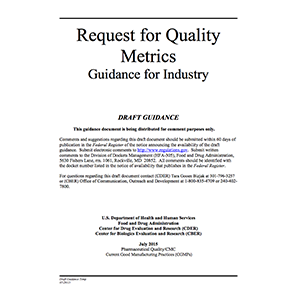Today, the FDA released its draft Guidance entitled, “Request for Quality Metrics.” The document outlines the FDA’s thinking on the use of quality metrics data “to help develop compliance and inspection policies and practices, such as risk-based inspection scheduling of drug manufacturers; to improve the Agency’s ability to predict, and therefore, possibly mitigate, future drug shortages; and to encourage the pharmaceutical industry to implement state-of-the-art, innovative quality management systems for pharmaceutical manufacturing.”
The FDA has published this draft Guidance in order to obtain comments prior to finalization, at which time, it will begin to request data relative to the quality metrics generated by certain manufacturing facilities required to register under Section 510 of the Federal Food Drug and Cosmetic Act. “The requests would not apply to: establishments that are not required to register under section 510 of the FD&C Act and regulations FDA has issued at 21 CFR 207.10; compounders operating under section 503A or registered as outsourcing facilities under section 503B of the FD&C Act; medical gas manufacturers; positron emission tomography manufacturers; and manufacturers of blood and blood components for transfusion, vaccines, cell therapy products, gene therapy products, allergenic extracts, human cells, tissues, and cellular and tissue based products and non-recombinant versions of plasma derived products.”
In developing the criteria for the type of data and metrics that the FDA plans to request, the Agency developed four tenents for its criteria, while acknowledging that there are other criteria that drive a quality pharmaceutical operation. The “metrics should be 1) objective, (2) subject to inspection under section 704 of the FD&C Act, and (3) valuable in assessing the overall state of quality of the product and process, commitment to quality by the manufacturer, and the health (i.e., effective functioning) of the associated PQS, while (4) avoiding any undue reporting burden.”
The document explains the FDA’s authority to request and collect these data and outlines how the Agency intends to use the data. The full Guidance can be found here and the Federal Register Notice announcing its availability can be found here . FDA plans on requesting the data prior to inspections, in order to aid in determining both the need for inspection and the depth of the detail of the inspection, and to make the inspection process more efficient. The Agency also plans on using the data gathered in conjunction with FDA’s internal data (e.g., past inspectional findings, recalls, etc.), and states that “[e]valuation of this information will enable FDA to work with establishments towards early resolution of quality problems and to reduce the likelihood that the establishment’s operations will be disrupted and impact the drug supply. FDA does not intend to publicly disclose quality metric data submissions.”
Using reported data described in the following section, FDA intends to calculate the following quality metrics for each product and establishment, where applicable:
- Lot Acceptance Rate = 1 – x (x = the number of specification-related rejected lots in a time frame divided by the number of lots attempted by the same establishment in the same time frame).
- Product Quality Complaint Rate = the number of product quality complaints received for the product divided by the total number of lots of the product released in the same time frame.
- Invalidated Out-of-Specification (OOS) Rate = the number of OOS test results for the finished product invalidated by the establishment divided by the total number of OOS test results divided by the total number of tests performed by the establishment in the same time frame.
- Annual Product Review (APR) or Product Quality Review (PQR) on Time Rate = the number of APRs or PQRs completed within 30 days of annual due date at the establishment divided by the number of products produced at the establishment.
The Guidance also has a section on optional metrics related to quality culture that the FDA may identify as necessary in its requests and evaluations, and is asking for stakeholder comments relative to the program. As with any new program, where FDA begins to collect additional or information in new formats for evaluation, there is always some initial trepidation by the industry. However, if the program accomplishes its goals of establishing a basis for risk-based inspection and reduction of potential drug shortages, then it is likely going to be a win-win-win for the Agency, the industry, and the American public.




